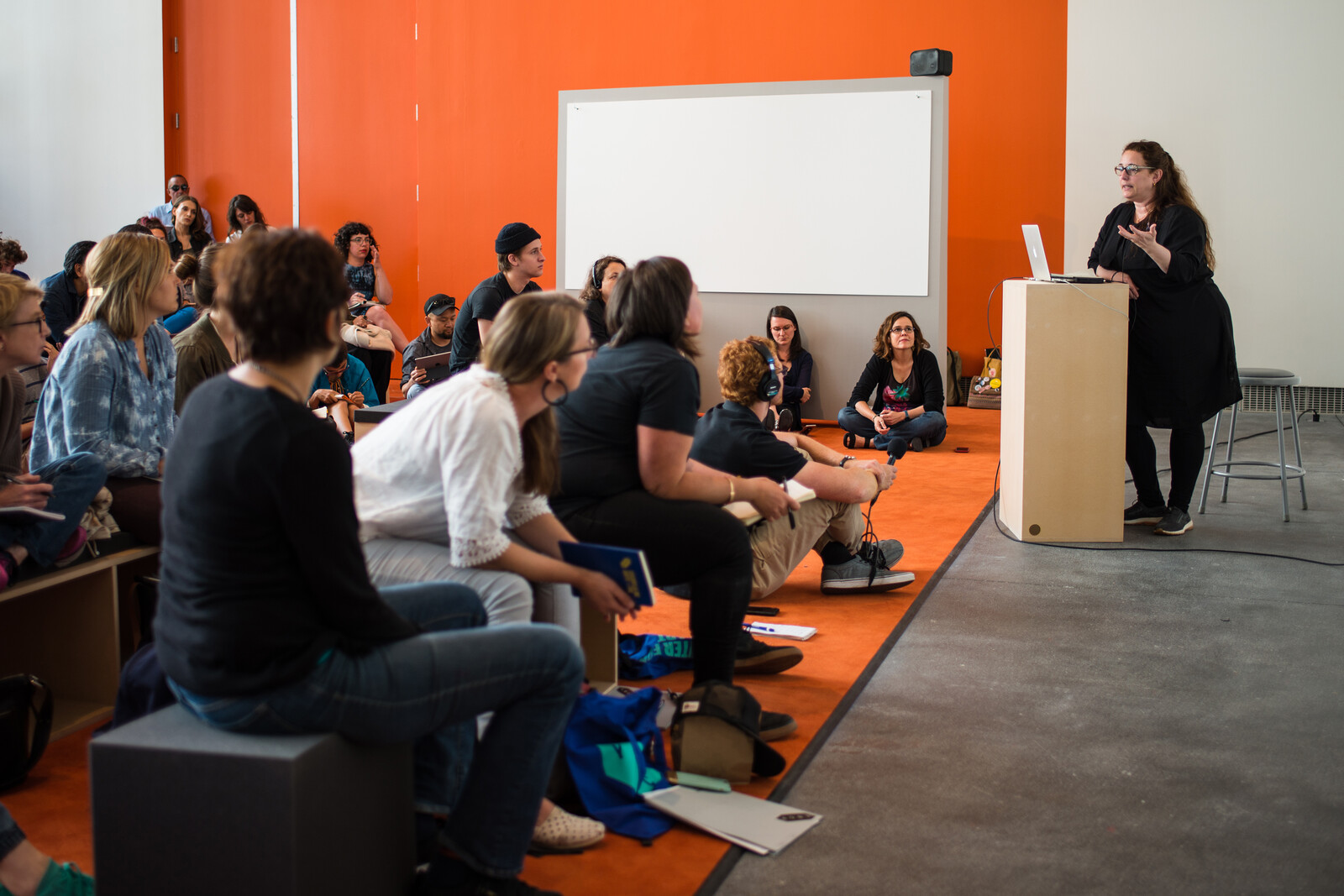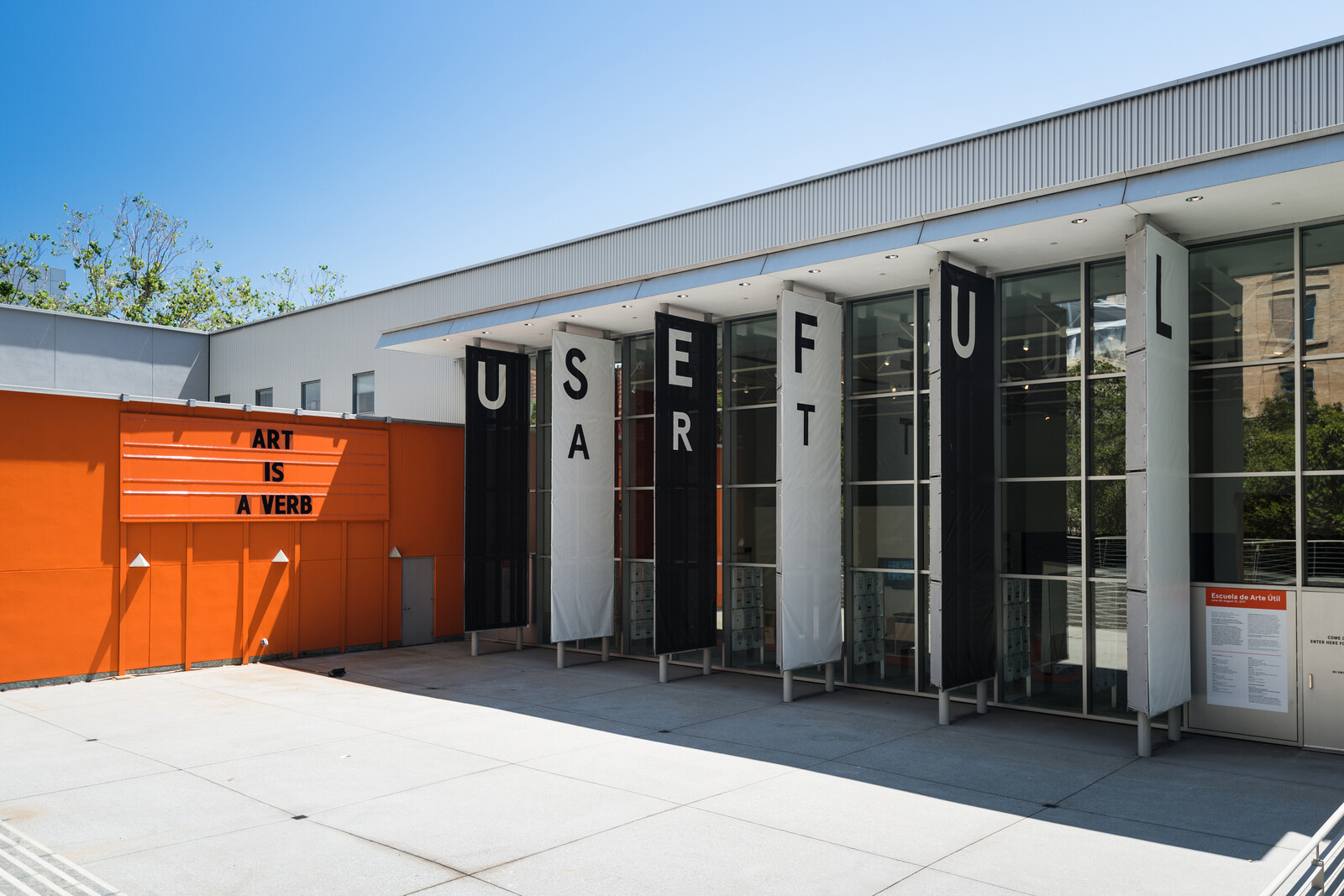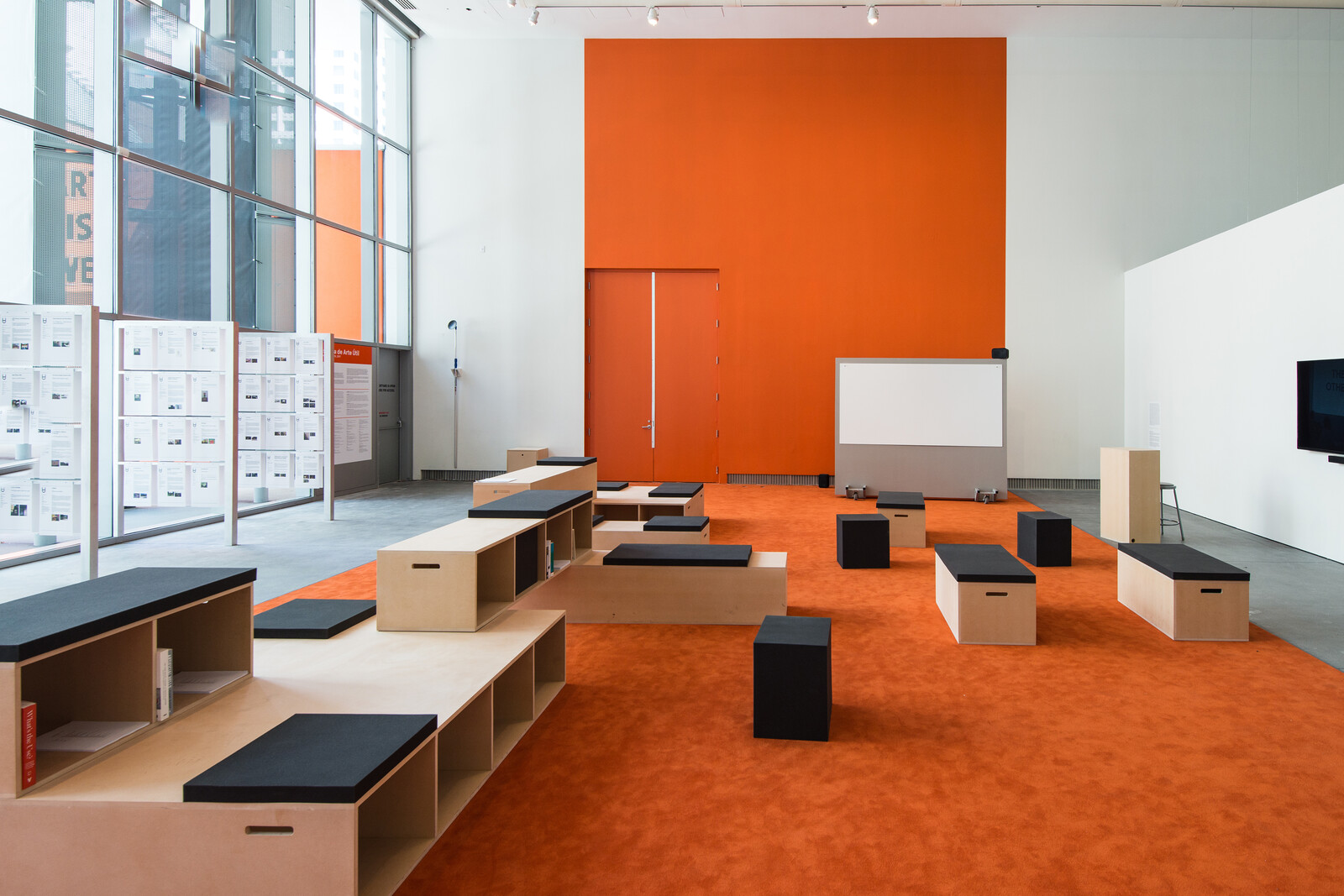This summer, Yerba Buena Center for the Arts, a non-collecting arts organization in San Francisco with strong activist roots and a focus on community engagement, opened a survey of work by Cuban artist Tania Bruguera. In addition to an overview of the artist’s major projects, “Talking to Power / Hablándole al Poder” included an eight-week alternative art school. Escuela de Arte Útil (School of Useful Art) focused on Bruguera’s carefully-defined conception of the type of socially-engaged art that has defined her practice for three decades. While “Arte Útil” literally translates into English as “useful art,” projects that meets the standards defined by the Asociación de Arte Útil demonstrate practical, urgent, and sustainable work designed to operate strategically as a larger social tool. Arte Útil does not merely offer some type of functional benefit to viewers; it renders an audience users of the work. Bruguera differentiates Arte Útil from other types of socially engaged art in terms of intention, not impact: “Every work of art is potentially useful, but Arte Útil is specifically researching how art can be a tool for social change.” Arte Útil specifically deploys artistic practice and research to generate and, crucially, implement strategies and tactics that disrupt or modify social structures and behavior.
The Escuela de Arte Útil is of a piece with Bruguera’s practice: operating between performance art and activism, Bruguera often intervenes in structures of power and proposes challenges, critiques, and viable alternatives in political, economic, and social life. Each of Bruguera’s works in “Talking to Power / Hablándole al Poder” was not just represented in the gallery space but updated for the survey’s time and location to remain relevant to its immediate context. For example, the ongoing long-term project Movimiento Migrante International (Immigrant Movement International) (2010–-), which has previously entailed the creation of a community space and think tank to addresses refugee and immigrant rights, was updated as the The Party of Migrant People’s Assembly (2017), which dedicated physical space to facilitate conversations among immigrant- rights organizations in the Bay Area. These updates reflect both the conceptual and practical importance of ensuring immediate relevance for Bruguera’s durational political performances, so that they avoid interpretation as documents and remain active, durational provocations.
In this same mode, the Escuela is an updated version of an earlier project, Cátedra Arte de Conducta (Behavior Art School) (2003–09), in which Bruguera ran an art school in her home in Havana. The Cátedra offered an art pedagogy focused on social practice and was presented as an alternative to Cuba’s sole art school. For its presentation at Yerba Buena Center for the Arts, the Cátedra’s mission of transforming public space through civic action was updated in form and focus to create the Escuela: “There are so many schools in California and elsewhere doing social practice projects now that the edge that the Cátedra Arte de Conducta had wouldn’t have existed. What would create the same kind of edge as the Cátedra would be to take on the discussion about Arte Útil, a concept that’s still very controversial and would create a fruitful conversation about the role of art today.”
The Escuela would exist as both a living performance within Bruguera’s practice and a model of Arte Útil’s tenets as a real, functional school challenging dominant forms of art-education institutions. Physically, the Escuela was situated in a large gallery on the first floor of the YBCA, in the main exhibition spaces showing Bruguera’s work. The Escuela’s context was crucial: that it existed not just in an art space but within an exhibition cannot be emphasized enough. The room devoted to the Escuela was marked by an endlessly changing configuration of chairs on a bright orange carpet, handwritten signs and posters fixed to the wall, and a palpable buzz of conversation and energy, creating the effect of a huge graduate seminar organized as a durational performance. The Escuela, its classes, and its participants would be on full display, and the divisions between art, its instruction, and its audience would be dissolved.
Students of the Escuela mentioned this performative aspect of the school almost without exception. Beatriz Escobar, a graduate student in Social Practice & Public Forms at California College of the Arts, found that the pedagogical use of the gallery space within the YBCA created a “very different dynamic,” compared to both the typical museum and graduate school experiences. “The fact that the Escuela was not held in the classroom, but rather a gallery in an institution, changed the power dynamics,” she explained. While many of the aspects of the school were structured like any other class—syllabus, lectures, and so forth— a fundamental difference emerged from the relationship of the Escuela to the survey exhibition in which it operated and the literal presence of students in the gallery that made every class function as both an educational experience and a performance. Escobar emphasized that the students were also performing in their final proposals, which also she also considereds part of the exhibition.
The Escuela represents a challenge to one of the features of contemporary art education in which students are asked to simulate or reiterate previous or existing gestures and ideas in art, which then become isolated in institutional frameworks. “What we ask in Arte Útil exercises,” Bruguera said, “is to join what is happening in the world and understand that change can only be done collectively and in collaboration with other people with other skills.” In other words, a student should not worry about making their banner more aesthetic or intellectual and presenting their effort. Instead, the banner should be introduced into an activist realm.
Art education’s tendency toward isolation is rooted at the institutional level: art schools are often taught and institutions are often conceived as isolated spaces. The Escuela supports an alternative ideology. It emerged as a collaboration among many institutions in the Bay Area that worked to ensure that the fifty officially enrolled students would receive course credit and stipends, which would make the Escuela free. Most of the regular Escuela attendees were students from the California College of the Arts; the San Francisco Art Institute; University of California, Berkeley; and San Francisco State University, along with participants in the center’s adult fellowship program. YBCA and the Asociación de Arte Útil, the organization led by Bruguera and Alistair Hudson, the director of the Middlesbrough Institute of Modern Art, with support from Van Abbemuseum, successfully negotiated with these Bay Area art- education institutions to grant credit in their place.
While the earlier Cátedra operated as a direct call for change to the one official art school in Cuba, the institutional provocations of the Escuela are more complex and subtle. “With this project, we are focused on collaboration between institutions as a way to create a lasting relationship instead of an exception. Education is the best way to put Arte Útil in the hands of people, by providing tools that can be implemented. The Escuela worked more like a virus that will, hopefully, contaminate institutions,” Bruguera said. As evidence of the Escuela’s impact on the Bay Area, Bruguera cited the cooperation among art schools that “normally compete with each other. Instead, we had a collaboration among institutions in order to have a conversation that involves all of us.”
According to Lucía Sanromán, the director of visual arts at the YBCA and co-curator of “Talking to Power / Hablándole al Poder” with curatorial associate Susie Kantor, the Escuela catalyzed difficult but important challenges that the institution was in the process of addressing. “As we continue to learn how to support socially engaged artists at YBCA, the question becomes how to implement a project that is truly active and participatory where audiences are constituencies, while also having enough visuality to contain a more temporary visitor experience based purely on spectatorship,” she explained. The legwork required to bring the Escuela into the YBCA was illuminating. For example, “the YBCA’s galleries are not particularly well-suited for a classroom setting. For us to break internally and even have a conversation about what people can bring to class—can they bring pens?, can they drink coffee?—becomes a conversation about democratizing the institution and its uses … The relationship to institutions runs two ways in Bruguera’s practice: through projects that emulate institutions while bettering them, making them more democratic and responsive, and through the art institutions that deploy her projects, which require a holistic internal shift in the way art and cultural institutions operate.”
The United States has a rich history of artist-initiated art schools, the most well-known being Black Mountain College, which was active in North Carolina from 1933 to 1957. Perhaps because it lasted less than twenty-five years, Black Mountain College established a precedent for alternative education platforms to be structured as provocations or experiments, rather than organizations focused on long-term institutional success. What differentiates the Escuela from other artist-run or alternative art schools operating today, beyond its specific focus on one type of art, is its role as a nexus between already -existing institutions rather than a self-conscious alternative, and its work to legitimate its labor within the credit system of these participating schools, activities that can essentially be reproduced anywhere, at any time. Notably, most of the students I interviewed explained that receiving course credit from their respective school (and a stipend) was a major reason for their participation in the Escuela, and at least one student felt that this may have occasionally undermined the program’s aims of coalition-building and critical engagement, exposing the tension between utopianism and pragmatism that seems impossible to avoid in this kind of project.
In other ways, the scope and scale of the Escuela was familiar: eight weeks of three four-hour classes per week, with readings, discussions, and a final project, which took the form of a group proposal for an Arte Útil work. Bruguera taught the first and last two weeks of the program; in between, a range of ambitious and influential artists and curators working in the field of social practice were guests each week, including Alistair Hudson, Debt Collective, Jeanne van Heeswijk, and the Vienna-based art collective WochenKlausur. I visited the Escuela at the end of July, when artist and community organizer Rick Lowe was guest instructor for the sixth week of the program, one devoted to “sustainable outcomes.”
Lowe dedicated the first section of the class I visited to answering the students’ open questions about his practice and projects. Many were focused on pragmatics, especially on how Lowe secured funding for Project Row Houses, the community-driven arts project to preserve buildings in Houston’s predominantly African-American Third Ward and transform them into studios for visiting artists. Lowe leveled with the students, first by noting that money is only one resource that gets projects moving, and then by urging students to think of their own creativity, time, ideas, and networks as resources within their grasp that could be harnessed now, long before applying for grants and appealing to patrons. Project Row Houses started with no money, Lowe explained, but when he and his first collaborators showed “real- time investment in the idea,” people showed up to support them. “The best way to get to support is to prove to people that you can do it without them,” he observed with a laugh, and once you’ve done so, they’ll “reassert their power by supporting you.”
Later in the class, Lowe gently pushed back on some of the activist collaborations created under the rubric of Arte Útil, not because of Bruguera’s conception of them but because of current understandings of art. “Activists want very specific, very substantial results” that cannot always be obtained from art, he observed during his conversations with students. Lowe seemed to warn students that there’s still a very limited understanding of how art works outside the art world, at one point suggesting that we are still decades away from the types of collaborations beyond the art world that the students might be hoping for. Students later told me in interviews that many of the guest instructors had helpfully complicated Bruguera’s definitions of useful art while remaining respectful to of the framework and archive that provided an anchor for discussions throughout the summer.
Later in Lowe’s class, groups of five to eight students presented their in-progress final projects. One group presented its working idea to combat harassment on BART, the Bay Area’s public transportation rail system, by distributing safety vests throughout BART cars. Citizens could put these vests on to assume the responsibility of protecting others from intimidation. The group of students had taken prototypes of these vests on BART, with mixed results. They relayed the challenges of implementing this process and their own experiences as a diverse group of students trying to explain the concept behind the vests to BART commuters. The presentation was easygoing and at times self-deprecating, but supported by a palpable sense of urgency: it had only been two months since two men had been killed on a Portland, Oregon commuter train while trying to product protect two young Muslim women from a man screaming racist insults at them, and the summer of 2017 saw raids by the Immigration and Customs Enforcement agency on immigrant communities nationwide. The group of students, one of the more diverse in the Escuela, was clearly weighing what was possible in bringing their prototype into the world.
Of the students I spoke with—those with a background in social practice and those without—almost all found the Escuela to be a force for challenging their preconceptions about how art operates. For Shaghayegh Cyrous, a graduate of the MFA in Social Practice program at California College of the Arts, becoming a fellow at Escuela immediately after graduating served as a powerful counterpoint to the more academic conversations about socially engaged art at CCA. At the Escuela, participants had to answer questions from a public unfamiliar with this kind of art and “even though we did many collaborations, even internationally, at CCA, at Escuela we actually faced [the public] more realistically.” Cyrous found Bruguera’s timelines, categorizations, and criteria for Arte Útil extremely helpful for her thinking, and like almost all the students I interviewed, she found that the visiting lecturers had bolstered and complicated her understanding of socially engaged art and its possibilities to create change. Gemma Godfrey, an undergraduate at Bard College studying art and experimental music, noted that the Escuela worked to “break down some of those barriers of museum-going that only focus on the aesthetic autonomous enjoyment of work.”
Despite the widely -felt benefits of working with peers from a wide range of backgrounds and knowledges about various art ontologies from other schools while learning a new set of apparatuses for making and understanding art, some participants had mixed reactions to the demographics and dynamics of the student body. Several felt that the mostly white cohort (from a range of national backgrounds) made conversations about race and coloniality problematic, and that they occasionally found themselves imagining how to solve problems for communities they knew little about. A graduate student at UC Berkeley, who wished to remain anonymous, felt the a lack of “intentional community building” in the program, and noted the tendency of some groups to perpetuate “white- savior narratives.” A student from Spain noted that the racial and socioeconomic profiles of the students could have been more diverse, but she emphasized the self-critical nature of the Escuela as “calling into question its normative uses and purposes, transforming what could have been a standard solo exhibition into an ever-changing collective project formed by its artist-educators and students.” The Escuela, she said, “made me question the effectiveness of my practice and the legitimacy of living in an aesthetic bubble.”
In late September, the San Francisco Museum of Modern Art co-produced with the Asociación de Arte Útil and the Yerba Buena Center for the Arts a symposium entitled “Does Art Have Users?” Among other concerns, the symposium took up the major provocation of Arte Útil—that art functions as a tool in the world—and contextualized it in terms of usership, both in Bruguera’s strict definition and in the language of Silicon Valley’s looser, capitalistic conceptualization of users. Bruguera spoke alongside theorist Stephen Wright, who has been instrumental in generating a lexicon for Arte Útil, and curator Oriol Fontdevila, with moderation by Sanromán. Fontdevila spoke of Arte Útil as a challenge to differentiate the ontologies of formalism and institutional critique: the first focused on the production and consumption of art as such, and the second is “always trying to escape” this structure, whether in the form of education or activism. Wright described the position of the Escuela within the YBCA as a new kind of “proto-institution” grappling with the challenge of integrating practices of substantial engagement into institutions that have for so long been organized by regimes of spectatorship. Wright noted that, contra the YBCA’s relationship to the Escuela, many institutions are still trying to “have their cake and eat it too” by keeping the larger frame of the institution, designed to showcase so-called “autonomous art,” unchanged while trying to find creative ways to incorporate practices like Arte Útil into conceptual and physical architectures that were not designed to host them. Wright’s provocation: What would Museum 3.0—one designed to embrace user-generated, user-oriented practices—look like?
Bruguera responded by explaining the ever -changing proposition of Arte Útil, which functions outside any academic orthodoxy as “a live concept that changes, adjusts, and proposes new things within its own logic.” She gave an account for of its beginnings as an archive “because we needed to understand its ontology, where it comes from, and so we can establish credibility with people who say this doesn’t exist; we can say no, there have been two hundred years of parallel practice.” They decided to create the Escuela because, after establishing the lineage and identity of Arte Útil, “we wanted to share this knowledge and create it together,” while also “infiltrating the syllabus of several schools and creating a situation that had never happened before.” She reframed Wright’s challenge within the tendency to objectivize performance as a product to be consumed: “How can we emphasize a shift from production to implementation?”
After this panel, groups of students from the Escuela presented their final proposals and prototypes of Arte Útil projects. Each project combined some form of institutional critique or provocation with a set of concrete practices both within and beyond institutions, and all were designed to change the world. Occasionally in these proposals, idealism ran aground on the shores of pragmatism, as with the group of students that suggested a worldwide dating platform as an answer for facilitating the crossing of controlled international borders. “Freedom of movement,” they argued, “is promoted as an international human right.” However, the group of students that presented a challenge to museums and other cultural institutions to turn physical space within their buildings into truly public places open for all citizens, could see its viability is reflected in SFMOMA’s initiative opening to open a public library branch in its lobby, complete with couches, where (at least the day I was there) visitors were resting and even drifting off into sleep, as well as reading newspapers and books.
The students who had been working on the anti-harassment vests for BART commuters had, since July, refocused their effort on cultural bridge-building. Their final proposal, “Mind the Gap,” offered a subtler intervention into the interpersonal interactions on public transportation. They proposed creating in this shared space a dialogic system wherein all BART users could write about their intercultural encounters with other riders, which would then be collected into readers and distributed to the public. And rather than self-identify via safety vests as a literal anti-harassment force, those who were brave enough could carry “placards that designate them as temporary resource persons for others who might have questions about their culture and identity.” While the end goal remained the same—to decrease harassment on BART created by cultural difference—the type of empowerment the students proposed shifted from mere safety within a physical space and into a pedagogical opportunity for users.
The students sought to address a universal experience through local means: while not every city has a BART, citizens worldwide negotiate public space in close contact with their neighbors but rarely enter open dialogue with them. If this change in their approach—from signaling, to engaging—is indicative of the outcome of their work with the principles of Arte Útil, education is clearly the best vehicle for their transmission. Bruguera has invested in the Escuela as one of her long-term projects: it will travel through 2019 with “Talking to Power / Hablándole al Poder” to Mexico City’s Museo Universitario Arte Contemporáneo in Mexico City and to Dublin’s Irish Museum of Modern Art in Dublin through 2019, and as an independent project to Richmond, Virginia and Toronto. The Escuela’s presentation at the Yerba Buena Center for the Arts incubated the “virus,” to use Bruguera’s description. As a “proto-institution” working directly with students, art, and communities, the Escuela de Arte Útil—, the performance and the ever -changing, continuously -updating pedagogical model— can challenge art education within and among its institutions through whichever users are willing to answer the call.
—Monica Westin







